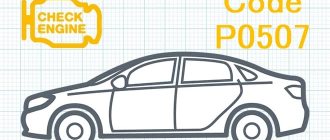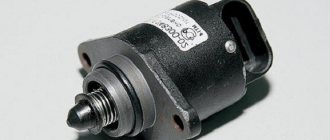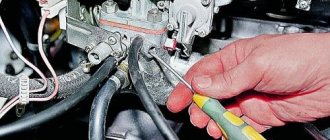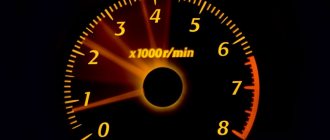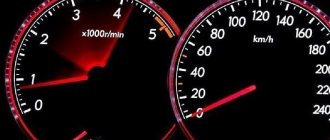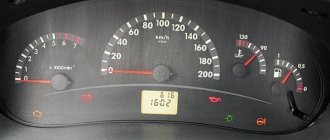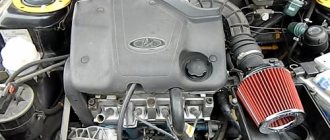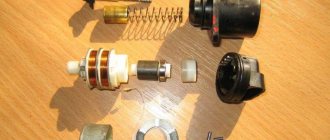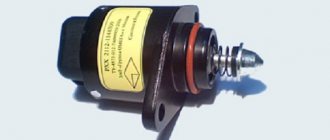How does a mechanic diagnose a P0507 trouble code?
When diagnosing this error code, a mechanic will do the following:
- Reads all stored error codes using an OBD-II scanner.
- Review all saved data and clear error codes.
- Will test drive the car to make sure there is a problem.
- Check the vacuum wires for damage and also check for intake air leaks.
- Check the throttle body for large amounts of carbon buildup and the throttle body for proper opening and closing.
- Determines the engine idle speed when checking the idle air control valve and oil pressure switch in the power steering system using a diagnostic tool.
- Check the battery charging system.
On which cars is this problem most common?
The problem with code P0507 can occur on different machines, but there are always statistics on which brands this error occurs more often. Here is a list of some of them:
- Audi (Audi a4)
- Chery (Chery Amulet, Tiggo, Fora)
- Chevrolet (Chevrolet Aveo, Cruz, Optra, Tahoe)
- Chrysler (Chrysler 300c)
- Daewoo
- Dodge (Dodge Caliber)
- Ford (Ford Focus)
- Geely
- GMC Sierra
- Honda (Honda Accord, SRV)
- Hyundai (Hyundai Accent, Getz, Santa Fe, Sonata, Tucson, Elantra)
- Infiniti (Infiniti fx35)
- Isuzu (Isuzu Trooper)
- Jeep (Jeep Grand Cherokee)
- Kia (Kia Magentis, Sorento, Spectra, Sportage)
- Lifan (Lifan Solano)
- Mazda (Mazda 3, Mazda 6)
- Mercedes (Mercedes e210)
- Mitsubishi (Mitsubishi Galant, Montero)
- Nissan (Nissan Hell, Altima)
- Opel
- Pontiac (Pontiac Sunfire, Grand Prix GXP)
- Saturn (Saturn SC)
- Skoda (Skoda Octavia)
- Subaru
- Volkswagen (Volkswagen Passat, Touareg)
- VAZ 2107, 2110, 2112, 2114, 2115
- Gazelle ZMZ 405
- Lada Kalina, Niva, Priora
With fault code P0507, you can sometimes encounter other errors. The most common ones are: P0068, P0106, P0118, P0171, P0174, P0300, P0301, P0420, P0505, P0506, P1125, P1515, P1295, P2279.
Source
Deciphering faults in the fuel and air systems
- P0030 - the oxygen sensor heater wire to the exhaust gas converter has broken;
- P0031 - the same electrical wire has shorted to ground;
- P0032 - the same wire has shorted to the on-board network (BS);
- P0036 - the wiring of the oxygen sensor heater is broken, after the converter;
- P0037 - the same wiring has shorted to ground;
- P0038 - it has shorted to BS;
- P0102 - weak signal in the mass air flow sensor network;
- P0103 - very strong signal in the network of this device;
- P0112 - weak signal in the air temperature sensor network;
- P0113 - very strong signal in the network of the same device;
- P0116 - antifreeze temperature sensor signal is out of operating range;
- P0117 - poor signal from the antifreeze temperature sensor network;
- P0118 - very strong signal from the antifreeze temperature sensor;
- Car diagnostics
P0122 - poor signal in the throttle position sensor circuit;
- P0123 - very strong signal in the same circuit;
- P0130 - the oxygen sensor before the converter does not work;
- P0131 - weak outgoing signal on the network of this device;
- P0132 - signal too strong on the same network;
- P0133 - slow response to changes in mixture quality in the network of the same device;
- P0134 - oxygen sensor circuit inactive;
- P0136 - the oxygen sensor after the converter is broken;
- P0137 - poor signal in the circuit of this device;
- P0138 - signal too strong in the same circuit;
- P0140 - the same sensor circuit is inactive;
- P0141 - the oxygen sensor heater after the converter is broken;
- P0171 - there is a lot of air in the fuel mixture;
- P0172 - there is a lot of gasoline in the fuel mixture;
- P0201 - injector wire No. 1 is broken;
- P0202 - injector wire No. 2 is broken;
- P0203 - injector wire No. 3 is broken;
- P0204 - injector wire No. 4 is broken;
- P0217 - engine overheated;
- P0230 - failure in the electric fuel pump relay network;
- Here we are looking for an electrical problem that has arisen.
P0261 - the injector circuit of cylinder No. 1 has shorted to ground;
- P0263 - injector driver No. 1 does not work;
- P0264 - the injector circuit of cylinder No. 2 has shorted to ground;
- P0266 - injector driver No. 2 does not work;
- P0267 - injector circuit No. 3 has shorted to ground;
- P0269 - injector driver No. 3 does not work;
- P0270 - injector circuit No. 4 has shorted to ground;
- P0262 - the injector circuit of cylinder No. 1 is shorted to the BS;
- P0265 - injector circuit No. 2 is shorted to BS;
- P0268 - injector circuit No. 3 is shorted to BS;
- P0271 - injector circuit No. 4 is shorted to BS;
- P0272 - injector driver No. 4 does not work.
Errors Lada Kalina 1st generation - decoding
Important! The list can also be used for the VAZ Priora model - the digital codes are similar for both cars.
Exhaust gas outlet (0000)
- 30 – open circuit or failure of the air sensor to the catalyst;
- 31 – break in the wiring from the short circuit to the vehicle;
- 32 – a similar incident involving contact with other wires;
- 36 – open circuit of the line after the catalytic converter;
- 37 – damage to the cable winding with a short circuit to the machine body;
- 38 – wiring break with short circuit at BS.
Interruptions in the air supply to the internal combustion engine (0101)
- 102 – damage or malfunction of the mass air flow sensor;
- 103 – short circuit in the MAF wiring;
- 112/13 – failure or incorrect operation of the fuel mixture temperature sensors in the intake manifold;
- 115-116 – violation of antifreeze t° sensors – there is no cooling of the system or the main airflow is not working properly;
- 117-118 – open circuit of the coolant temperature sensor power supply/short circuit;
- 122/123 – defect in cable insulation at the TPS;
- 130/131 – error/break in DC circuit No. 1;
- 132 – short circuit of sensor No. 1 PCV;
- 133/134 – the air sensor connection is broken (sometimes it’s enough to clean the terminals and connector) or the wiring is damaged;
- 135 – malfunction of heater DK2;
- 136 – contact with the body of the DK2 highway;
- 137/138/140 – uncontrolled signal DK2 or break of the corresponding line;
- 141 – failure or interruption of heating of DC2;
- 171/172 - violation of mixture formation in the first case - depletion, for the second - excessive enrichment.
Error codes Lada Kalina 1.6 liters, indicating an uncontrolled violation in the fuel line (0200)
- 201-204 - a rupture in the control line for injectors 1-4, usually manifested by tripling or even doubling of the internal combustion engine, and the power plant may not start;
- 217 – critical temperature rise of the engine block;
- 230 - Lada Kalina error, accompanied by a drop in power or problems starting the power plant, is caused by a violation of the fuel filter relay circuit;
- 263/266/269/272 – the injector control driver has failed in sequence from No. 1 to No. 4;
- 261/267/270/264 – insulation violation of the injector control wire with a short circuit to vehicle ground for elements 1-4;
- 262/265/268/271 – similar to the previous point, only with a 12 volt touch.
Error codes Kalina 8 valves caused by incorrect ignition activation (0300)
- 300 – misfire or no spark for all pistons;
- 301/302/303/304 – similar to the previous number with clarification for each boiler sequentially;
- 325 – problems with the functioning of the DD;
- 327/328 – the mixture detonation sensor does not work correctly;
- 335/336 – failure or incorrect information is received from the DPKV unit;
- 337/338 – similarly with touching ground or other wires;
- 340 – wire break or DRF has failed;
- 342/343/346 – incorrect operation of the phase distribution indicator, possible short circuit;
- 351-354 – poor contact to the ignition coils, or damage to the wiring, for all boilers in series;
- 363 - dry pistons, no gasoline or oxygen, possible blockage or air bubble in the line.
Secondary equipment not related to the ECM (0400)
- 422 - the catalyst is clogged, excess pressure forms in the pipe, usually a complete replacement of the unit is required;
- 441 – the adsorber purge valve is faulty; cleaning or repair may be required;
- 443-445 – rupture of the purge line with the formation of a short circuit (possibly to the body);
- 480/481 – the insulation of the power cables to the main radiator fan is damaged.
Lada Kalina engine error - incorrect crankshaft speed (0500)
- 501/502 – electronic speed sensor readings are too low or high;
- 503 – contacts on the DC have oxidized, the block may be damaged;
- 505 – XO floats, you need to check the regulator;
- 506 – the engine does not hold idle speed, throttle adjustment is required;
- 507 – similar to the previous paragraph, speed float is added, TPS repair may be necessary;
- 511 – the XX regulator is faulty, perhaps it should be replaced with a new one;
- 560/562/563 – voltage surges in the vehicle network – we are looking for where the short circuit is.
Malfunction of on-board wiring lines (0600)
- 601 – failure or unstable operation of the ROM;
- 603-604 – incorrect data from internal or external RAM circuits;
- 607 – possible disruption of the detonation line;
- 615-617 – damage to the power supply wire of the auxiliary PC with a permissible short to 12 volts or ground;
- 627-629 – breakdown of the fuel pump power supply with the possibility of a short circuit;
- 645-647 – the clutch of the air conditioner pump unit is de-energized with or without a short circuit in the wiring;
- 650 is a typical Lada Kalina check error, indicating that the corresponding lamp on the dashboard has burned out:
- 654 – the electrical line of the engine speed meter is faulty;
- 685-687 – breakdown of the insulation of the main relay power cables with a possible short circuit;
- 691-692 – rupture of the wires supplying voltage to the main fan with the possibility of a short circuit to the remaining parts of the wiring.
Additional error codes on Lada Kalina (1000)
- 102/115 – disappearance of resistance or breakdown of the DC;
- 123-124 – incorrect formation of the XX mixture;
- 127-128 – similar to the previous paragraph, only at low load;
- 135 – damage to wiring DK1;
- 136-137 – incorrect mixing of air and gasoline components at low load on the internal combustion engine;
- 140 – the difference between the actual and calculated load is too large;
- 171 – potentiometer readings are underestimated;
- 172 – the opposite meaning of the above paragraph;
- 386 – incorrect data from the combustible mixture detonation channel sensor;
- 410 – break in the adsorber purge line;
- 425-426 – also with short circuit to ground or network;
- 500 – break in the fuel pump network;
- 501-502 – similar with a ground fault or 12 volts;
- 509 – critical overload of the idle speed controller;
- 513-514 – short circuit of the remote control sensor at idle speed of the internal combustion engine;
- 541 – the fuel pump has “died” or the voltage on the line has disappeared, it is also possible that a crack in the liner may form with fuel getting inside the structure;
- 570/600 – an erroneous impulse is received from the APS or there is none at all (sometimes cleaning the contact group helps);
- 602 – the ECU “shorts” at 12 volts;
- 603 – the firmware has crashed – a reboot is required;
- 606/616 – the rough road sensor indicates incorrect information (it begins to act up due to shaking on the “beautiful” asphalt);
- 612 – the ECU data was reset incorrectly, a forced reboot is required;
- 617 – the pothole indicator has died for a long time or the terminal has come loose;
- 620-622 – irreparable failure of the PROM, RAM or EEPROM blocks, respectively;
- 640 – software “glitch”;
- 689 – no problems were found during diagnostics – the encodings shown are false.
Symptoms of malfunction
The main driver symptom of P0507 is the MIL (Malfunction Indicator Light). It is also called Check engine or simply “check light”.
They can also appear as:
- The “Check engine” warning light on the control panel will light up (the code will be stored in memory as a malfunction).
- Floating speed, as well as attempts to stall at idle.
- Idle speed is higher or lower than normal.
- The engine may stall if the idle speed is not maintained by pressing the accelerator pedal.
Depending on the symptoms, the severity of a P0507 code can range from moderate to severe. Therefore, it is recommended to resolve this issue as soon as possible.
VAZ P0507 High idle speed
Code P0507 is entered if:
there are no fault codes P0102, P010З, P0115, P0117, P0118, P0122, P0123, P0444, P0445, P1509, P1513, P1514; the engine is idling; coolant temperature above 84°C; within 3 seconds, the crankshaft speed of the N10 engine is less than 900 rpm; within 3 seconds, the current correction of the calculated idle air flow IV exceeds 10 kg/h.
If a permanent malfunction occurs, the “CHECK ENGINE” lamp lights up after 2 drive cycles.
The idle speed control is checked using the TDRKH-1 tester (Samara) or J-34730-3 (from UTS. USA).
HOW TO CHECK:
Connect the adapter cable to the diagnostic connector. Start the engine and warm it up to a coolant temperature of 84°C. Using the Errors menu, check whether the fault code is currently active.
Code P0507 is intermittent. If it is currently inactive and there are no other codes, analyze the conditions under which the code occurred.
High idle speed may be caused by a problem that cannot be overcome by the idle speed control. To troubleshoot problems not related to the idle air control, the following checks must be performed.
Over-lean mixture. The idle speed may be low or unstable. Check the fuel supply system for low fuel pressure, water in the fuel or dirty injectors. Check the oxygen sensor for contamination with silicone, glycol or other materials.
Crankcase ventilation system. A malfunction of the crankcase ventilation system can lead to deviations in idle speed. See Map C-7.
Check the system for air leaks. If a malfunction is detected, correct it.
1. Disconnect the harness connector from the regulator. Connect the idle air control tester wires to the battery, then connect its connector to the idle air control control. Start the engine.
Using the tester, control the regulator by setting the idle speed to decrease.
If the idle speed decreases, replace the controller. If they do not decrease, replace the idle speed control.
After repair, start the engine, reset the codes and make sure there is no signal from the “CHECK ENGINE” lamp.
Diagnosis and problem solving
Connect the scanner, read and write down all available codes. This information may be useful if an intermittent fault is later diagnosed.
If other codes are present along with P0507, diagnose and resolve them in the order in which they were stored. The most likely additional codes are usually related to the vacuum system.
Therefore, check the vacuum system for leaks caused by damaged vacuum lines. If necessary, repair and clear all codes before operating the vehicle. Then, retest the system to see if any codes are returned.
Throttle valve
If the code persists, remove the throttle body from the intake tract and inspect it for excessive carbon deposit buildup. In some cases, it may be possible to remove light carbon deposits from the throttle body and auxiliary air passages using approved cleaners.
However, heavy deposits usually cannot be removed without damaging the throttle body or idle air control valve. In these cases, the best option is to replace the throttle body or idle air control valve with original parts.
When installing cleaned or replaced parts, ensure that all seals and gaskets are also replaced to prevent vacuum leaks. Double check all vacuum line connections before starting the engine or operating the vehicle.
Checking wires and connections
If the P0507 code persists, perform a thorough visual inspection of all associated wiring. Look for damaged, burnt, shorted or corroded wires and connectors.
Once no visible damage is found, check resistance, ground, and reference voltage. Compare all readings obtained with the data specified in the manual. Replace wiring as necessary to ensure all readings are within manufacturer specifications.
Stepper motor and idle control valve
Check the actual signal voltage that reaches the stepper motor at the connector. Using a scanner, command the idle air control valve to open. Compare the obtained value with the values specified in the manual.
Special diagnostic programs usually produce a voltage range that corresponds to the degree of opening of the idle air valve. And sometimes the degrees of rotation of the stepper motor.
These readings must correspond exactly to the stated values, otherwise the harness must be replaced. If all readings obtained are consistent with the stated values, the stepper motor is faulty and must be replaced.
These steps should solve the problem with error P0507. But if it still appears again, then perhaps the problem is periodic. In such a case, diagnosis can be challenging. And sometimes it is necessary to give the malfunction a chance to worsen in order to understand exactly where the problem is.
